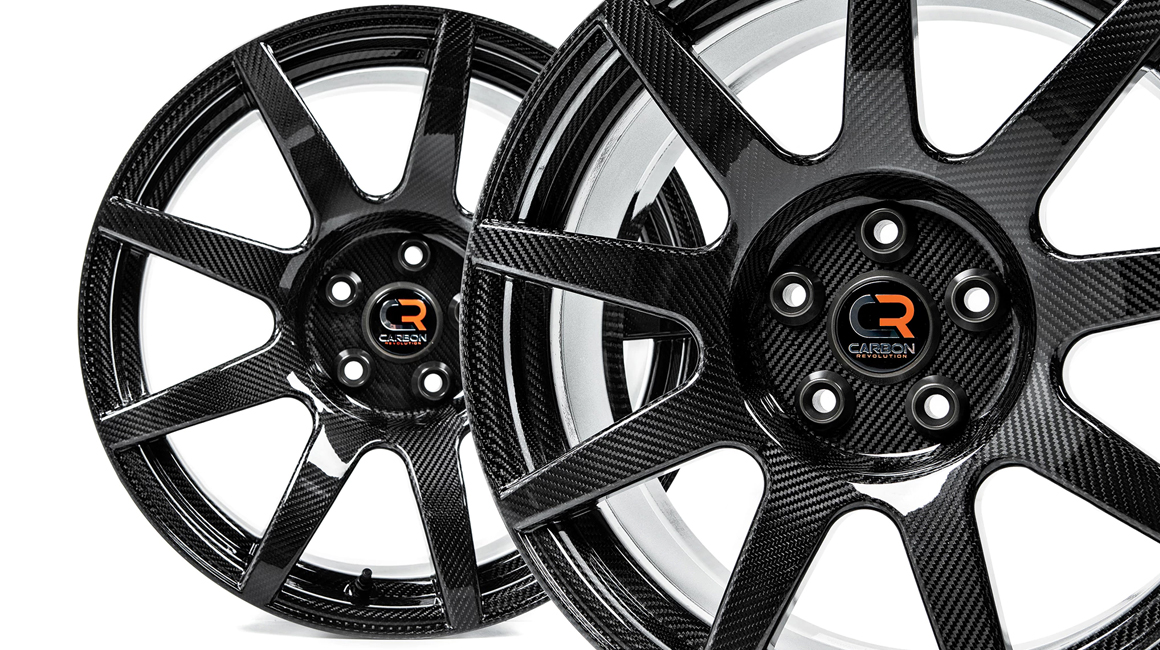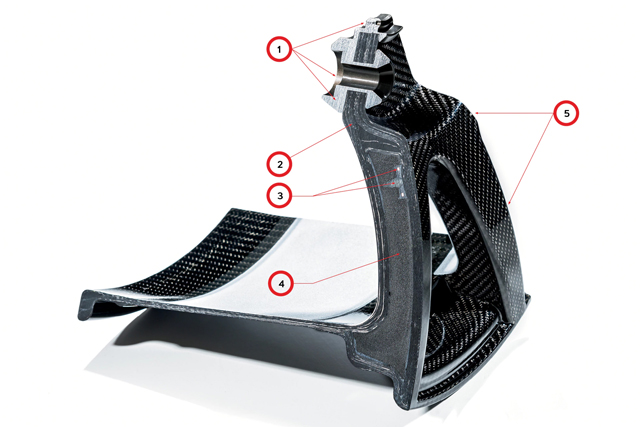The Future of Carbon-Fiber Rims
07 May 2018
Emerging high-end wheel technology appears headed for the mainstream
SOURCE Automobile Magazine
Way back in the early 1970s, Michelin made a run of composite glass-fiber and resin wheels for Citroën’s SM-based rally car. The first car equipped with them won its first race, the 1971 Morocco Rally. By 1972 they were offered as a factory option for buyers of road-going SMs.
In the 1980s, Dodge and Carroll Shelby teamed up for the CSX, the final version of which, the 1989 CSX-VNT, wore a set of composite wheels called Fiberrides. Like the Michelin/Citroën wheels before them, the Fiberrides were a composite glass fiber construction.
Fast-forward to 2013, when boutique hypercar maker Koenigsegg began offering carbon-fiber one-piece wheels for its 250-plus-mph ground-bound spaceships. They’re quite a pretty penny, however: A set of four will set you back about $40,000—on top of the roughly $2 million price tag for one of its cars.
Carbon fiber’s ability to tolerate a wide range of temperatures without becoming brittle or deformable depends not on the carbon itself but on the epoxy that surrounds it.
Today, Porsche is the only mainstream automaker developing one-piece carbon-fiber wheels in-house, and there’s just one supplier, Carbon Revolution, manufacturing them for production cars, including the Ford GT, Mustang GT350R, and several upcoming models from other brands—though there are a number of other outfits making “hybrid” carbon/alloy wheels for the aftermarket. Carbon Revolution has big plans to scale up from the tens of thousands of one-piece carbon-fiber wheels it says it will produce this year into the hundreds of thousands if not millions as it moves into the next decade. Sooner if co-founder Brett Gass has his way.
“We’ve got a program underway that’s a 22-inch carbon-fiber wheel for a very serious off-road SUV,” Gass said. “And those types of volumes in that world, those are tens of thousands of vehicles. Those are big programs.”
Carbon Revolution is also working with Ferrari on wheels for the 488 Pista, as editor-in-chief Mike Floyd learned at this year’s Geneva auto show. “We were very demanding with the style,” Edoardo Rossi, Ferrari product marketing manager for the 488 Pista, said of Ferrari’s work with Carbon Revolution to develop the Pista’s special wheel option. “The spokes are not huge spokes that you see in normal carbon-fiber components. They are very thin, so it was an adjustment. Then we developed together the solution that you see inside, the white coating. It is basically a coating developed from aerospace to preserve the carbon wheel from the heating of the brakes.”
The Advantage
Although lighter weight is the primary benefit of a composite wheel—particularly a carbon-fiber one—there are also advantages to be gained in the noise, vibration, and harshness arena. Metal wheels, including steel and aluminum, transmit a great deal of high-frequency NVH from the road through the suspension and into the car’s structure. Carbon-fiber wheels damp that energy better, cutting it out of the equation where it begins. As a result, carmakers will be able to engineer quieter cabins without having to add pounds and pounds of sound insulation.
“Not only the light weight and the stiffness, but the damping characteristics really just get rid of that high-frequency [vibration], particularly in the luxury electric vehicle space, where you don’t have powertrain and exhaust noise and all those other things,” Gass explained.
Lighter wheels improve acceleration and dece-leration, as the engine and brakes no longer need to work against as much rotating mass. They also reduce gyroscopic effects, making initial turning behavior more sensitive and controlled, and the amount of unsprung weight at each corner—the byproducts of which are improved ride comfort and more desirable handling characteristics thanks to a lessening of the suspension’s overall workload.
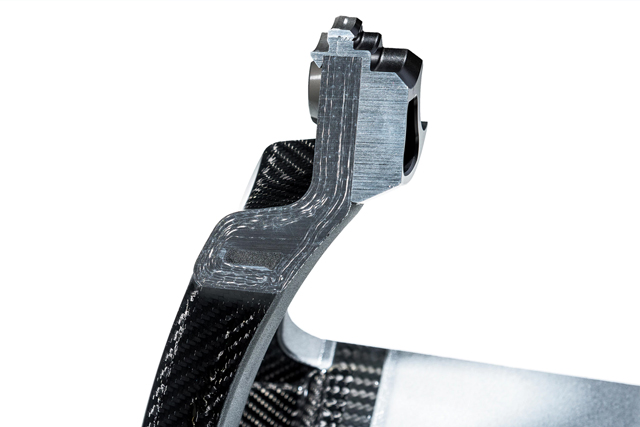
Every aspect of the carbon wheel that aids per-formance also benefits efficiency for the same reason—physics: You’re able to do the same or more with less energy. The only difference is the goal. Rather than chasing terminal velocity and optimum lap times, lightweighting a hybrid or electric car helps to maximize its range. With less mass in the wheel to be spun up to speed and then dragged back down, there’s less energy going to waste every time the car speeds up or slows down, which can mean miles (or tens of miles) more to a charge or a tank.
The “But”
So carbon-fiber wheels can unlock greater performance potential, improve efficiency, and enhance comfort and quietness. They seem like the perfect solution, so why all the fear, uncertainty, and doubt? Two reasons: price and myths.
A set of Carbon Revolution’s aftermarket wheels will run you about $12,000. Although that’s competitive with the very top end of the custom forged alloy wheel aftermarket, there’s no $1,000-a-set option as yet in the carbon-fiber space. But that will change over time as volume—and eventually competition—increases.
“Today we’re not really a disruptive technology,” Gass said. “We’re too expensive, too exotic. When we get to gen three of the technology where we’re cost competitive with forgings and superior in every product attribute, now you’re disruptive. Now you’re a real threat to a good chunk of the aluminum market. We’re not far off. We’re one generation of production away from that, which could show up on the road in the next two to three years.”
What Gass calls the “rarest automotive light-weighting technology in existence” today (he claims there are more suppliers for the LaFerrari KERS hybrid system than for one-piece carbon-fiber wheels) could conceivably become ubiquitous within the next decade, wheels that not just supercars but potentially every car will roll on. But that will only happen if the mythmongers are proven wrong.
The Myths
Carbon is fragile! Carbon shatters! You can’t repair it! Carbon wheels will melt when they’re hot! They’ll crack when they’re cold! They leak air!
The litany of fake news fatal flaws of the carbon-fiber wheel is not quite endless, but it’s certainly extensive. And none of it is true—at least if the wheel is made correctly. The seed of the myths was planted by a handful of aftermarket wheels, most of them two- or three-piece “hybrids” (carbon barrels with alloy hubs and spokes), none of them tested to OEM standards for road use. They’re very different creations from the fully tested one-piece wheels from Porsche, Koenigsegg, and Carbon Revolution.

The multipiece, multimaterial nature of hybrid carbon/alloy wheels presents additional points of failure compared to a traditional one-piece wheel, regardless of the material. The alloy center section has to be mated to the carbon-fiber barrel, typically by bolts, and each presents an opportunity for shear and strain to cause failure of the joint. Worse, when you bolt the aluminum center section to the carbon barrel, there’s likely to be some twisting that adds internal stresses and pulls the wheel out of true.
That’s not to say that all hybrid wheels are bad or inherently flawed. In fact, some hybrid wheels, including those produced by Carbo Tech (supplier of hybrid carbon wheels to BMW and Rolls-Royce as well as some of McLaren’s road-going carbon monocoques) and Geric, are built to meet or exceed the parameters of standard alloy wheels, not just in terms of stiffness but also of durability and toughness. Hybrid wheels are a factory option on the excellent BMW M4 GTS, a car vaunted for its handling and performance.
As for repair, carbon-fiber wheels—whether one-piece or hybrid—can be polished and resurfaced provided any scratching (hello, curb!) is limited to the surface epoxy layer and doesn’t disturb the carbon fiber below. That’s not too different from fixing an alloy wheel; no matter the material, you take a big enough chunk out of one or bend one too far, and there’s no repairing it back to its original strength and stiffness.
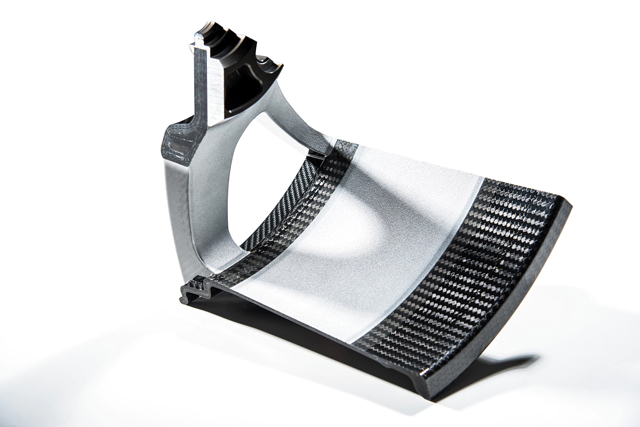
Although concerns about carbon fiber’s ability to handle extreme temperatures are legitimate, they’re misplaced. Carbon fiber’s ability to tolerate a wide range of temperatures without becoming brittle or deformable depends not on the carbon itself but on the epoxy that surrounds it—and wheelmakers like Carbon Revolution have put a lot of science into their secret sauce, including the plasma coating inside the wheel to protect the epoxy from brake heat. The result is a wheel that’s as strong and as safe to use in the Arctic as it is at a midsummer Arizona track day—otherwise that wheel never would have ended up on a car like the Ford GT.
Present and Future
Porsche’s upcoming optional wheel for the 911 Turbo S Exclusive Series is a one-piece braided-carbon unit that’s so tricky to create that Porsche decided it had to build a special circular loom (the world’s largest) just to weave the carbon into the wheel form. Ford’s decision to go with Carbon Revolution for its Mustang GT350R and GT supercar wheels also lends support to the idea that one-piece carbon-fiber wheels might be something worth spending for—even when you normally design your own.
A one-piece carbon-fiber design also opens the market to a wealth of future possibilities, including the advent of the smart wheel.
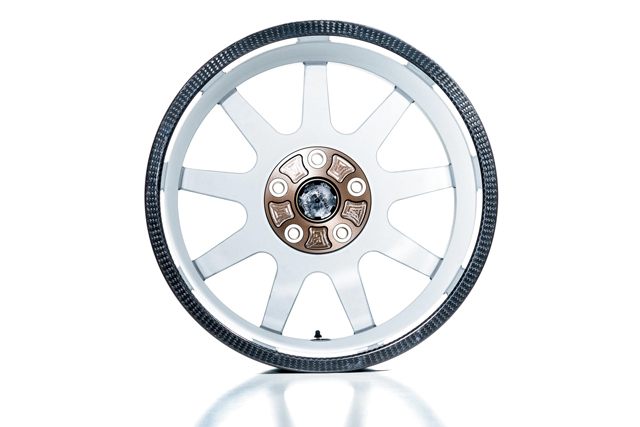
“There’s all kinds of stuff going on as far as the carbon wheels themselves and the manufacturing process,” Gass said. “I can embed wires and sensors inside of a wheel, so there’s a whole range of options and technology there to integrate into the vehicles.” In fact, every Carbon Revolution wheel is already embedded with an RFID chip that’s used for tracking and quality control throughout the manufacturing process.
Carbon Revolution has put a lot of science into its secret sauce, including its plasma coating inside the wheel to protect the epoxy from brake heat.
Beyond integrating pressure, temperature, and other sensors directly into carbon wheels, there are also new designs and geometries that can be realized thanks to their unique method of construction.
“The parallel I’d draw is the bike industry, where the early carbon-fiber road bike and mountain bike frames were butt joints,” Gass said. “Once it was painted, you couldn’t tell if it was a metal bike or a carbon bike. As the technology evolved from manufacturing to the studio and the industrial design side, you’d know it was painted carbon just because of the structure and its shape. … Wheels haven’t gotten there yet. The [design] studios, they’re just not mature enough. They haven’t learned enough about the technology.”
As they become more familiar with the process of creating carbon-based wheels, designers will be able to stretch beyond developing them for aesthetic benefits alone. Once the computational fluid dynamicists get involved, for example, we might all have a dash of Formula 1-level tech at each corner of our car. “One of the things that’ll be neat is when you think about efficiency on future vehicles, aerodynamics will play a big role,” Gass said.
As the world grapples with how to reduce carbon in the atmosphere (or at least how to reduce the amount we pump into it), it’s a bit ironic that one of the things that will help achieve that goal could be carbon itself. But it’s becoming increasingly hard to deny that’ll be the case and that the next frontier of the Carbon Age is upon us.
Cross Section: Carbon Revolution CR9
- The central portion uses an alloy structure to mate the wheel to lugs and hub face. All metal hardware is pressed in after the molding process and can be serviced with simple hand tools.
- Each portion of the wheel is made of many layers of carbon fiber, each with different weave directions and material properties to maximize strength.
- This odd cross section with copper inserts is an interior view of the RFID chip Carbon Revolution uses to track each wheel throughout the manufacturing and quality assurance processes.
- A rigid, lightweight foam is injected into the interior cavity of the wheel during manufacture to ensure the inner surface of the carbon maintains shape and position during molding. The foam itself provides no structural strength to the finished wheel.
- The exterior of each wheel is covered in a purely aesthetic top layer of carbon fiber and a glossy epoxy finish. The appearance-focused nature of that top layer leaves a lot of room for tailored looks.
